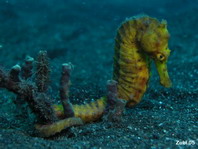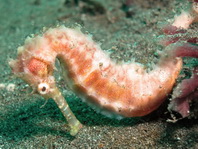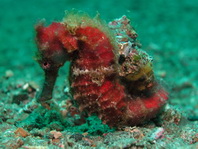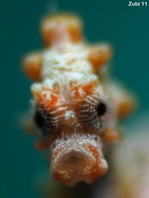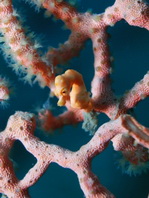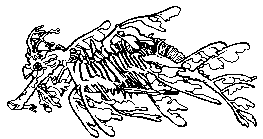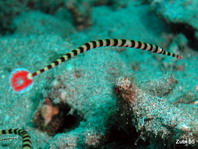|
|
||||||||
| Diese Seite auf Deutsch |
Multi-celled animals (Metazoa) |
|||||||
BONY FISHES |
CHORDATA (VERTEBRATES)
|
|||||||
|
Family of pipefishes (Syngnathidae) is divided into 4 subfamilies, the seahorses (Hippocampinae), the seadragons (Solegnathinae), the pipefishes (Syngnathinae) and the flagtailed pipefishes (Doryhamphinae), each with various genera. Over 1000 photos of bony fishes (one page each about pipefishes, seahorses and ghostpipefishes and sea moths) - Index of all Fish photos - Index only photos of Seahorses and Pipefishes |
||||||||
|
|
||||||||
|
Seahorse
male seahorse with young emerging from the pouch
|
CharacteristicsSeahorses have elongate bodies encased in bony rings. No pelvic fins but most have small pectoral fins and a single dorsal fin. Tubelike mouth / snout with no teeth. Small gill openings. Syngnathids can move their eyes independently (like chameleons). Seahorses have a prehensile tail. Ecology and rangeSeahorses inhabit coral reefs and sea grass beds. Some inhabit brackish or freshwater habitat. They prefer sheltered areas and are well camouflaged. They are found all over the world. BehaviorSeahorses swim upright with their tails down and their heads up. They feed on small crustaceans employing a sit- and - wait strategy, remaining stationary and snapping prey that comes near. With their tubelike mouth they create a vacuum that draws their prey into the mouth. Seahorses are capable of rapid color transformations to blend with their surroundings. While mating they also change colors either lightening or darkening their skin. Seahorses are monogamous and during the mating period they engage in a lengthy courtship. The male seahorse carries the eggs in a brood pouch where they are fertilized and incubated until they hatch. Seahorses are being overcollected. Please help preservation efforts and don't use them in aquariums. Reports indicate for example, that the Hippocampus population in the central Philippines have diminished by 70% between 1985 and 1995! Thousands of seahorses are imported to Europe, the United States and Japan as pets for aquariums. Dried seahorses are often offered as souvenirs, don't buy them! However the biggest consumer is traditional Chinese, Japanese and Korean medicine. Dried seahorses are used to "cure" a wide range of illnesses such as asthma, arteriosclerosis skin diseases but most important sexual dysfunction. The annual consumption by Asians nations of dried seahorses has been estimated at 45 tons (= ca. 16 mill. individuals!). |
|||||||
Photos of seahorses (photo collection) click for enlargement
|
||||||||
|
Seadragons |
|
|||||||
|
|
||||||||
|
Flagtailed pipefishes
|
CharacteristicsAll pipefish have an elongate bodies encased in bony rings. No pelvic fins but most have pectoral fins and a single dorsal fin. Tubelike mouth with no teeth. Small gill openings. Syngnathids can move their eyes independently (like chameleons). Flagtailed pipefishes (Doryhamphinae) have very striking color patterns like bands or stripes on their body and spots or stripes on the fanlike tail. Some pipefish clean other animals (like cleaner wrasses). Pipefishes (Syngnathinae) are slender and have a elongate body, mostly well camouflaged. Ecology and rangePipefishes inhabit sheltered aeras in coral reefs, sea grass beds and sandy lagoons. Some inhabit brackish or freshwater habitat. They are found all over the world. BehaviorThe pipefishes swim in a more fishlike fashion. They feed on small crustaceans employing a sit- and - wait strategy, remaining stationary and snapping prey that comes near. With their tubelike mouth they create a vacuum that draws their prey into the mouth. Pipefish form pairs. The males brood the developing eggs in a thinskinned abdominal pouch until they hatch. |
|||||||
Photos of pipefishes (photo collection) click for enlargement
|
||||||||
index - Coral reefs - The ocean - Reefs at risk - Major endangered reef regions (hotspots) - photo collection - starfish site mapLINKS ABOUT FISHES |
||||||||
. Copyright Teresa Zubi


